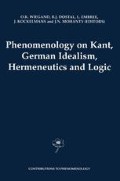Abstract
Imagine that we proceed along a line through the middle of a disk that is divided into two precisely symmetrical segments, one of which is red, the other green, and that we pass continuously from the red to the green segment. What happens as we pass the boundary between the two? Do we pass through a last point p 1 that is red and a first point p 2 that is green? Clearly not, given the density of every continuum; for then we should have to admit an indefinite number of further points between p 1 and p 2 which would somehow have no colour. To acknowledge one of p 1 and p 2 but not the other, however, as is dictated by the Dedekindian treatment of the continuum, would be to countenance a peculiar privileging of one of the two segments over the other, and an unmotivated asymmetry of this sort we can surely reject as a contravention of the principle of sufficient reason. Perhaps, then, the line becomes colourless at the point where it crosses the segmentary divide, so that the red and green segments would be analogous, topologically, to open regions. One might seek support for this idea by reflecting that extensionless points are not in any case the sorts of things that can be coloured, since colour properly applies only to what is spatially extended. Imagine, however, a perfectly homogeneous red surface. Are the points and lines within the interior of this surface not then also red?
Access this chapter
Tax calculation will be finalised at checkout
Purchases are for personal use only
Preview
Unable to display preview. Download preview PDF.
References
Brentano, Franz.. (1988). Philosophical Investigations on Space, Time and the Continuum. London/New York/Sydney: Croom Helm.
Cartwright, Richard. (1975). “Scattered Objects”. K. Lehrer (ed.). Analysis and Metaphysics. Dordrecht: Reidel, 153–71. Repr. in R. Cartwright. Philosophical Essays. Cambridge (MA): MIT Press, 1987, 171–86.
Casati, Roberto and Varzi, Achille. (1994). Holes and Other Superficialities, Cambridge, Mass.: MIT Press.
Chisholm, Roderick M. (1992/93). “Spatial Continuity and the Theory of Part and Whole. A Brentano Study”. Brentano Studien 4, 11–23.
Husserl, Edmund. (1966). Zur Phänomenologie des inneren Zeitbewusstseins (1893–1917). R. Boehm (ed.). The Hague: Martinus NijhofF(Husserliana X).
Smith, Barry. (1995). “On Drawing Lines on a Map”. Andrew U. Frank and Werner Kuhn (eds.). Spatial Information Theory. A Theoretical Basis for GIS (Lecture Notes in Computer Science 988), Berlin/Heidelberg/New York, etc.: Springer, 475–484.
Smith, Barry.. (1997). “Boundaries: An Essay in Mereotopology”. L. H. Hahn (ed.). The Philosophy of Roderick Chisholm (Library of Living Philosophers). Chicago and LaSalle: Open Court, 534–61.
Smith, Barry and Varzi, Achille C. (forthcoming) “Fiat and Bona Fide Boundaries”. Philosophy and Phenomenological Research.
Author information
Authors and Affiliations
Editor information
Editors and Affiliations
Rights and permissions
Copyright information
© 2000 Springer Science+Business Media Dordrecht
About this chapter
Cite this chapter
Smith, B. (2000). Zeno’s Paradox for Colours. In: Wiegand, O.K., Dostal, R.J., Embree, L., Kockelmans, J., Mohanty, J.N. (eds) Phenomenology on Kant, German Idealism, Hermeneutics and Logic. Contributions to Phenomenology, vol 39. Springer, Dordrecht. https://doi.org/10.1007/978-94-015-9446-2_13
Download citation
DOI: https://doi.org/10.1007/978-94-015-9446-2_13
Publisher Name: Springer, Dordrecht
Print ISBN: 978-90-481-5448-7
Online ISBN: 978-94-015-9446-2
eBook Packages: Springer Book Archive

